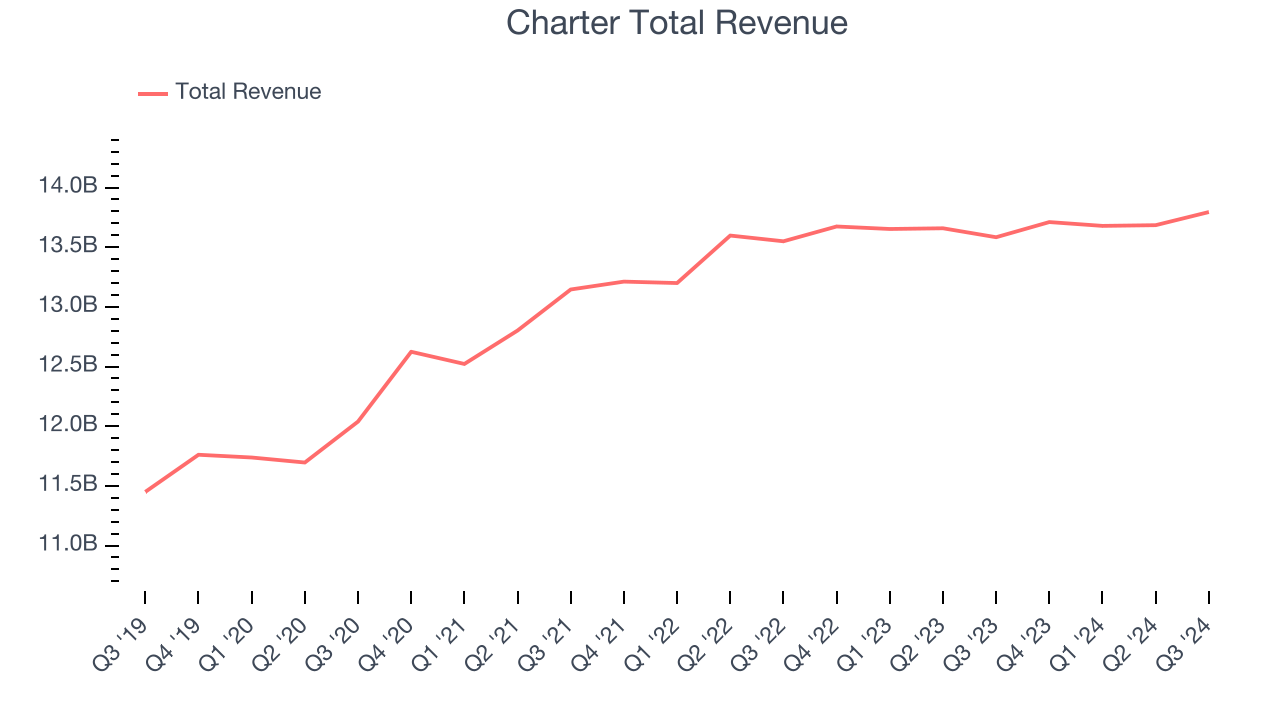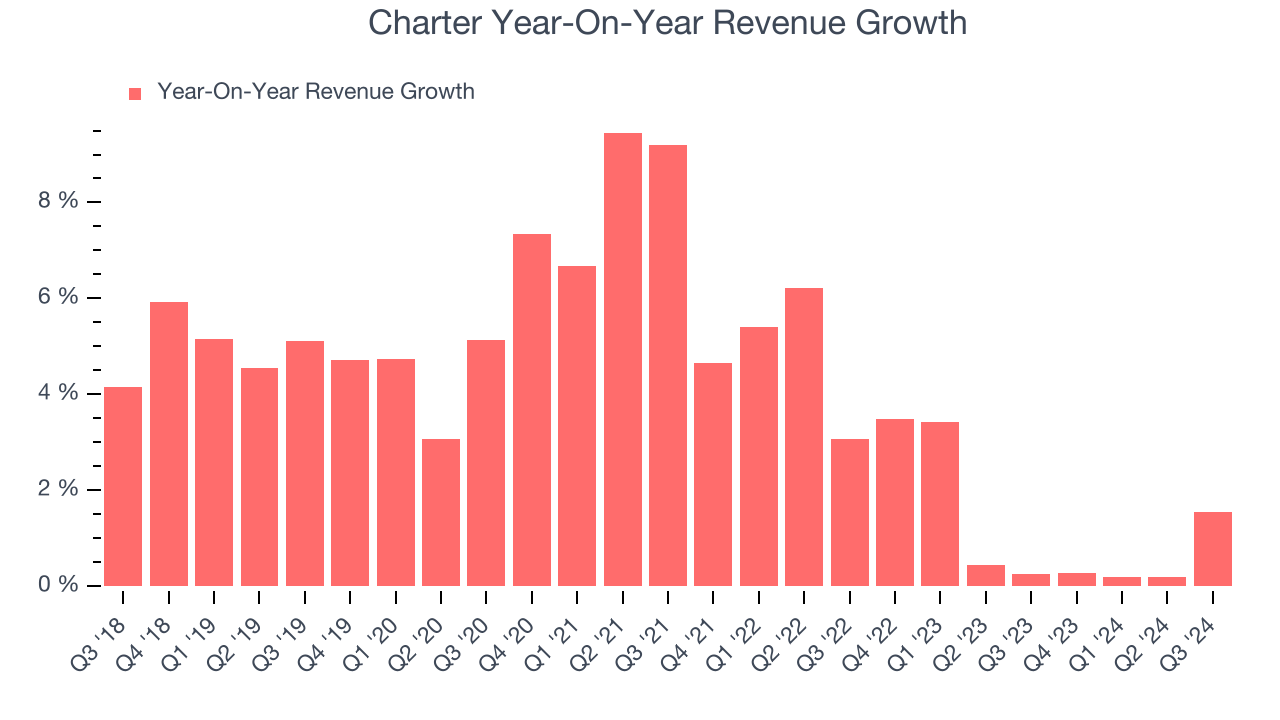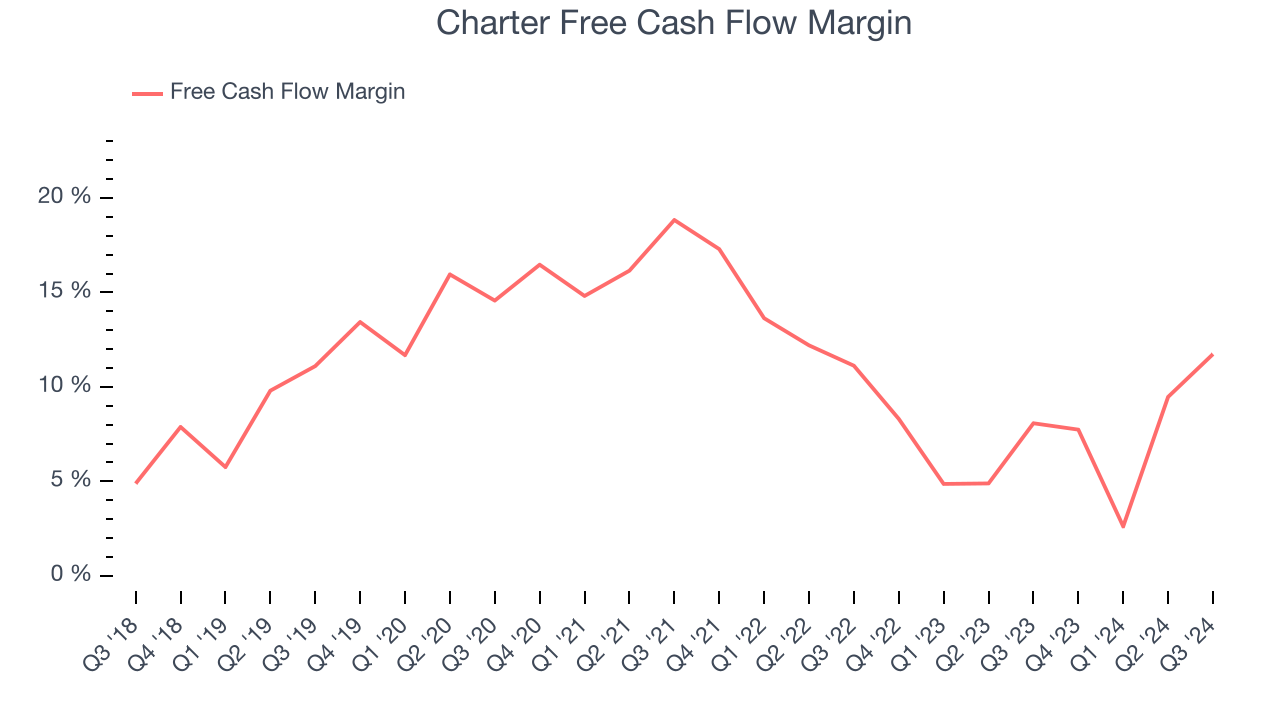
Cable, internet, and telephone services provider Charter (NASDAQ:CHTR) met Wall Street’s revenue expectations in Q3 CY2024, with sales up 1.6% year on year to $13.8 billion. Its GAAP profit of $8.82 per share was 3.9% above analysts’ consensus estimates.
Is now the time to buy Charter? Find out by accessing our full research report, it’s free.
Charter (CHTR) Q3 CY2024 Highlights:
- Revenue: $13.8 billion vs analyst estimates of $13.66 billion (in line)
- EPS: $8.82 vs analyst estimates of $8.49 (3.9% beat)
- EBITDA: $5.65 billion vs analyst estimates of $5.57 billion (1.3% beat)
- Gross Margin (GAAP): 39.9%, in line with the same quarter last year
- Operating Margin: 24.2%, up from 23% in the same quarter last year
- EBITDA Margin: 40.9%, in line with the same quarter last year
- Free Cash Flow Margin: 11.7%, up from 8.1% in the same quarter last year
- Internet Subscribers: 28,205 at quarter end
- Market Capitalization: $46.76 billion
"We executed well during the third quarter, building on our operating strategy and foundational investments," said Chris Winfrey, President and CEO of Charter.
Company Overview
Operating as Spectrum, Charter (NASDAQ:CHTR) is a leading telecommunications company offering cable television, high-speed internet, and voice services across the United States.
Wireless, Cable and Satellite
The massive physical footprints of cell phone towers, fiber in the ground, or satellites in space make it challenging for companies in this industry to adjust to shifting consumer habits. Over the last decade-plus, consumers have ‘cut the cord’ to their landlines and traditional cable subscriptions in favor of wireless communications and streaming video. These trends do mean that more households need cell phone plans and high-speed internet. Companies that successfully serve customers can enjoy high retention rates and pricing power since the options for mobile and internet connectivity in any geography are usually limited.
Sales Growth
Reviewing a company’s long-term performance can reveal insights into its business quality. Any business can have short-term success, but a top-tier one sustains growth for years. Over the last five years, Charter grew its sales at a sluggish 3.9% compounded annual growth rate. This shows it failed to expand in any major way, a rough starting point for our analysis.

Long-term growth is the most important, but within consumer discretionary, product cycles are short and revenue can be hit-driven due to rapidly changing trends and consumer preferences. Charter’s recent history shows its demand slowed as its annualized revenue growth of 1.2% over the last two years is below its five-year trend. 
This quarter, Charter grew its revenue by 1.6% year on year, and its $13.8 billion of revenue was in line with Wall Street’s estimates.
Looking ahead, sell-side analysts expect revenue to decline 1.2% over the next 12 months, a slight deceleration versus the last two years. This projection is underwhelming and indicates the market thinks its products and services will see some demand headwinds.
Today’s young investors won’t have read the timeless lessons in Gorilla Game: Picking Winners In High Technology because it was written more than 20 years ago when Microsoft and Apple were first establishing their supremacy. But if we apply the same principles, then enterprise software stocks leveraging their own generative AI capabilities may well be the Gorillas of the future. So, in that spirit, we are excited to present our Special Free Report on a profitable, fast-growing enterprise software stock that is already riding the automation wave and looking to catch the generative AI next.
Cash Is King
Although earnings are undoubtedly valuable for assessing company performance, we believe cash is king because you can’t use accounting profits to pay the bills.
Charter has shown weak cash profitability over the last two years, giving the company limited opportunities to return capital to shareholders. Its free cash flow margin averaged 7.2%, subpar for a consumer discretionary business. The divergence from its good operating margin stems from its capital-intensive business model, which requires Charter to make large cash investments in working capital and capital expenditures.

Charter’s free cash flow clocked in at $1.62 billion in Q3, equivalent to a 11.7% margin. This result was good as its margin was 3.7 percentage points higher than in the same quarter last year, but we wouldn’t put too much weight on the short term because investment needs can be seasonal, causing temporary swings. Long-term trends trump fluctuations.
Over the next year, analysts predict Charter’s cash conversion will fall. Their consensus estimates imply its free cash flow margin of 7.9% for the last 12 months will decrease to 4.2%.
Key Takeaways from Charter’s Q3 Results
It was encouraging to see Charter slightly top analysts’ revenue and EPS expectations this quarter. Overall, this quarter had some key positives. The stock traded up 4.4% to $342 immediately following the results.
Big picture, is Charter a buy here and now? What happened in the latest quarter matters, but not as much as longer-term business quality and valuation, when deciding whether to invest in this stock. We cover that in our actionable full research report which you can read here, it’s free.













